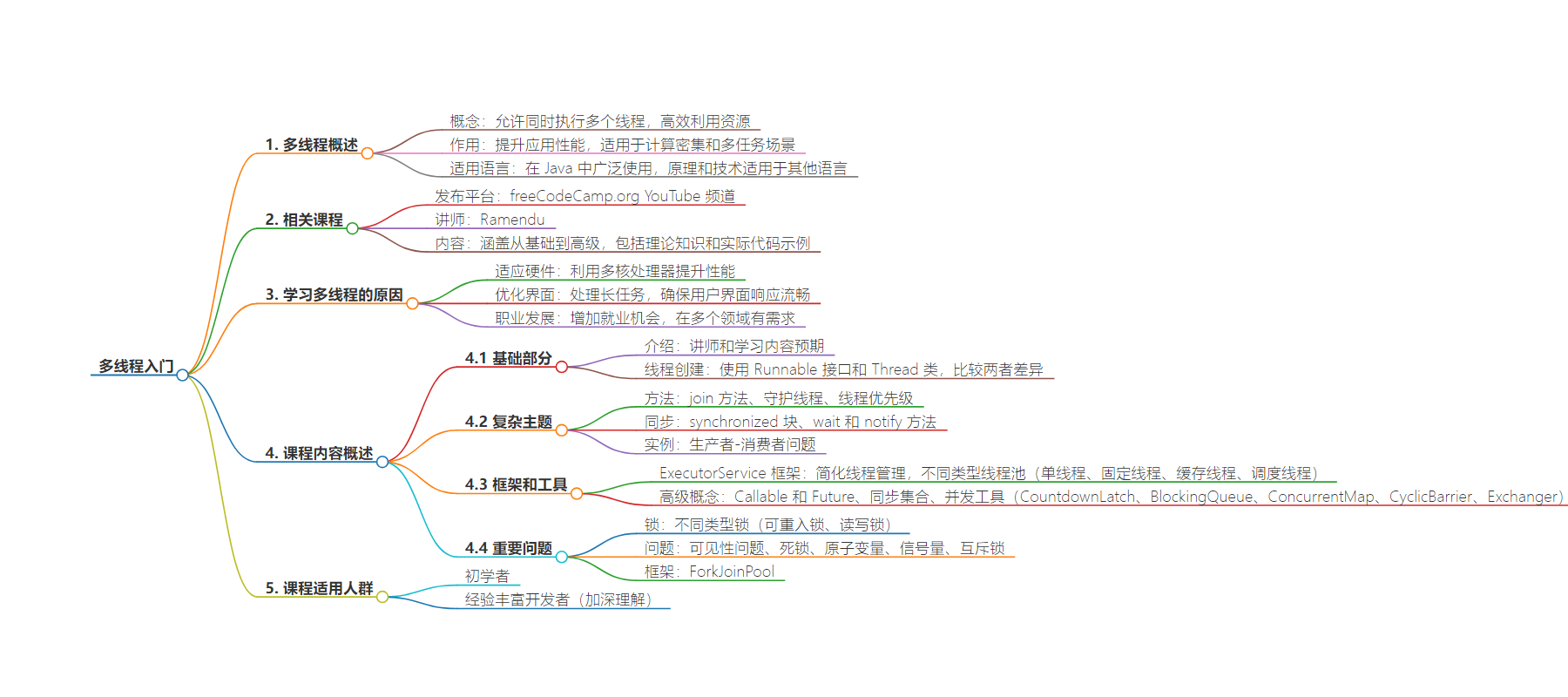包阅导读总结
1.
关键词:Multithreading、Java、Computer Science、Programming Skills、Resource Optimization
2.
总结:本文介绍了多线程在计算机科学中的重要性,新发布的 Java 多线程课程,学习多线程的原因,如提升性能、创造更多职业机会等,并简述了课程内容,适合不同水平开发者学习。
3.
主要内容:
– Multithreading 概念
– 允许并发执行线程,优化资源利用,提升应用性能
– 适用于计算密集和多任务处理
– Java 多线程课程
– 在 freeCodeCamp.org YouTube 频道发布
– 由 Ramendu 创建
– 涵盖从基础到高级的内容,有理论和实践
– 学习多线程的原因
– 适应多核处理器,提高 CPU 密集型任务性能
– 保证用户界面响应,提升用户体验
– 增强编程技能,增加职业机会
– 课程内容概述
– 从基础介绍开始
– 包括创建线程的方法、复杂主题、线程管理框架、高级概念、关键问题等
– 以总结和感谢语结束,适合各水平开发者
思维导图:
文章地址:https://www.freecodecamp.org/news/multithreading-for-beginners/
文章来源:freecodecamp.org
作者:Beau Carnes
发布时间:2024/7/16 20:31
语言:英文
总字数:541字
预计阅读时间:3分钟
评分:84分
标签:多线程,Java,并发编程,软件开发,性能优化
以下为原文内容
本内容来源于用户推荐转载,旨在分享知识与观点,如有侵权请联系删除 联系邮箱 media@ilingban.com
Multithreading is a crucial concept in computer science that allows for the concurrent execution of two or more threads, enabling more efficient and optimized use of resources. It can significantly improve the performance of applications, particularly those that require heavy computational work or need to handle multiple tasks simultaneously. Understanding multithreading is essential for developing robust and efficient software, especially in languages like Java where this concept is extensively used.
We just published a course on the freeCodeCamp.org YouTube channel that will teach you all about multithreading in Java. This comprehensive course covers everything from the basics to advanced topics, providing both theoretical knowledge and practical code examples. While the primary focus is on Java, the principles and techniques discussed are applicable to other programming languages as well. Ramendu created this course.
Why Learn Multithreading?
Multithreading is fundamental to creating high-performance applications. With the rise of multi-core processors, leveraging multiple threads has become essential to fully utilize the capabilities of modern hardware. Applications that perform CPU-intensive tasks, such as data processing, simulations, and complex calculations, can see large performance improvements when implemented with multithreading. Additionally, multithreading is important for creating responsive user interfaces in applications where long-running tasks are offloaded to separate threads, preventing the UI from freezing and ensuring a smooth user experience.
Learning multithreading not only enhances your programming skills but also opens up numerous career opportunities. Many high-demand fields, including game development, finance, and big data, require a solid understanding of concurrent programming.
Course Content Overview
The course begins with an introduction to the instructor and an overview of what you can expect to learn. You’ll start with the basics, such as understanding what multithreading is and how it differs from sequential execution. From there, you’ll learn how to create threads using both the Runnable interface and the Thread class, and explore the differences between these two approaches.
As you progress, the course teaches more complex topics such as the join method, daemon threads, and thread priority. You’ll learn about synchronized blocks and the potential problems they can cause, as well as how to use the wait and notify methods for inter-thread communication. The producer-consumer problem is also covered, providing a practical example of these concepts in action.
The course also introduces the ExecutorService framework, which simplifies thread management by providing a pool of reusable threads. You’ll explore different types of executors, including single-thread, fixed-thread, cached-thread, and scheduled-thread pools, and learn how to choose the ideal pool size for your needs. Advanced concepts such as Callable and Future, synchronized collections, and various concurrency utilities like CountdownLatch, BlockingQueue, ConcurrentMap, CyclicBarrier, and Exchanger are also covered.
Towards the end of the course, you’ll learn about the importance of locks and how to use different types of locks such as reentrant locks and read-write locks. The visibility problem in Java, deadlocks, atomic variables, semaphores, and mutexes are discussed to provide a thorough understanding of these critical issues. Finally, the course covers the ForkJoinPool, an advanced framework for parallel execution, before concluding with a summary and a thank-you message.
This course is perfect for anyone looking to master multithreading in Java, from beginners to experienced developers seeking to deepen their understanding. Watch the full course on the freeCodeCamp.org YouTube channel (6-hour watch).
VIDEO
